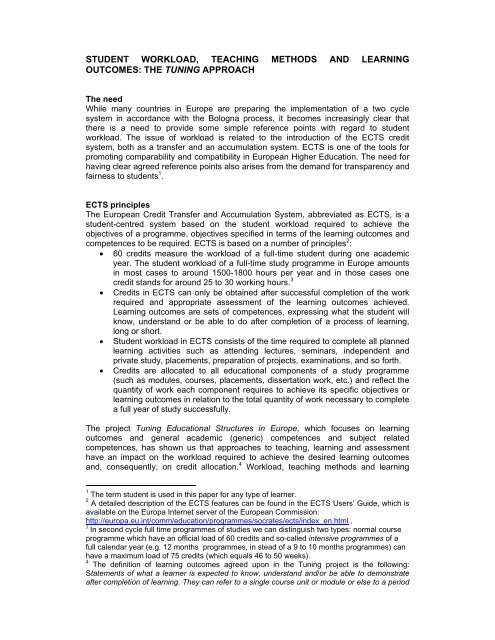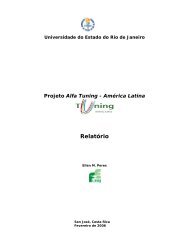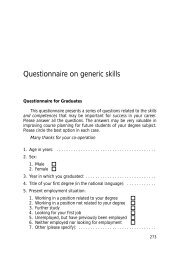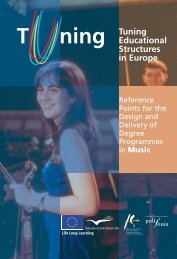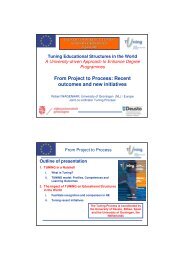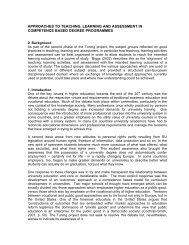student workload, teaching methods and learning ... - ECOMMIS
student workload, teaching methods and learning ... - ECOMMIS
student workload, teaching methods and learning ... - ECOMMIS
You also want an ePaper? Increase the reach of your titles
YUMPU automatically turns print PDFs into web optimized ePapers that Google loves.
outcomes are clearly related to each other. However, there are other relevantelements. In achieving the desired <strong>learning</strong> outcomes a large number of interrelatedfactors play a role. The diversity of traditions has to be taken into account, as well ascurriculum design <strong>and</strong> context,, coherence of the curriculum, <strong>teaching</strong> organisation,ability <strong>and</strong> diligence of the <strong>student</strong>. In other words, the time required to achieve thesame <strong>learning</strong> outcomes may vary according to the context 5An approach for determining <strong>student</strong> <strong>workload</strong> in Higher Education programmesWhen deciding on the <strong>student</strong> <strong>workload</strong> the following elements are of relevance:• The <strong>student</strong> has a fixed amount of time depending on the programme he/she istaking.• The overall responsibility for the design of a programme of studies <strong>and</strong> thenumber of credits allocated to courses lies with the responsible legal body, e.g.faculty executive board, etc.• The final responsibility for deciding on the <strong>teaching</strong>, <strong>learning</strong> <strong>and</strong> assessmentactivities for a particular amount of <strong>student</strong> time is delegated by faculty <strong>and</strong>university authorities to the teacher or the responsible team of staff.• It is crucial that the teacher be aware of the specific <strong>learning</strong> outcomes to beachieved <strong>and</strong> the competences to be obtained.• The teacher should reflect on which educational activities are more relevant toreach the <strong>learning</strong> outcomes of the module / course unit.• The teacher should have a notion of the average <strong>student</strong> work time required foreach of the activities selected for the module / course unit.• The <strong>student</strong> has a crucial role in the monitoring process to determine whetherthe estimated <strong>student</strong> <strong>workload</strong> is realistic, although monitoring is also aresponsibility of the <strong>teaching</strong> staff.of studies, for example, a first or a second cycle programme. Learning outcomes specify theminimum requirements for award of credit. Learning outcomes are formulated by academicstaff.The Tuning Project focuses on subject specific competences <strong>and</strong> generic competences. Thesecompetences represent a dynamic combination of knowledge, underst<strong>and</strong>ing, skills, abilities<strong>and</strong> values. Fostering these competences are the object of educational programmes.Competences, which are obtained by the <strong>student</strong>, will be formed in various course units <strong>and</strong>assessed at different stages.Learning outcomes according to Tuning methodology should be formulated in terms ofcompetences. Competences may be developed to a greater degree than the level required bythe <strong>learning</strong> outcome.5 ‘Educational Structures, Learning Outcomes, Workload <strong>and</strong> the Calculation of ECTS Credits’,in Julia Gonzalez <strong>and</strong> Robert Wagenaar, eds., Tuning Educational Structures in Europe. Finalreport - Phase One (Bilbao <strong>and</strong> Groningen 2003).
An approachI. Module(number of credits / <strong>student</strong> hours)IV. Adjustment ofthe unit either withregard to thenumber of creditsallocated or theeducationalactivitiesII. Planningeducationalactivities /determining<strong>student</strong> timeinvolvedIII. Checking of <strong>workload</strong> by <strong>student</strong>evaluations in terms of real timeinvolvedFour stepsTo realize the overall objective, namely the development of an approach which leads toa truly valid consideration of a <strong>student</strong>’s <strong>workload</strong>, implementation of the following foursteps is recommended.I. Introducing modules/course unitsA choice must be made between the use of a modularized or a non-modularizedsystem. In a non-modularized system each course unit can have a different number ofcredits although the total credits for each academic year will still be 60. In amodularized system the course units/modules have a fixed number of credits, 5 creditsfor example, or a multiple of this number. The use of a modularized system in aninstitution facilitates the use of the same modules by <strong>student</strong>s enrolled in differentprogrammes.II. Estimating <strong>student</strong> <strong>workload</strong>The <strong>workload</strong> of a module/course unit is based on the total amount of <strong>learning</strong> activitiesa <strong>student</strong> is expected to complete in order to achieve the foreseen <strong>learning</strong> outcomes.It is measured in time (in work hours); for example, a module of 5 credits allows foraround 125-150 hours of work of a typical <strong>student</strong>.Educational activities can be defined by considering the following aspects:• Modes of instruction (types of <strong>teaching</strong> <strong>and</strong> <strong>learning</strong> activities): lecture, seminar,research seminar, exercise course, practical, laboratory work, guided personalstudy, tutorial, independent studies, internship, placement or ‘stage’, fieldwork,project work, etc.• types of <strong>learning</strong> activities: attending lectures, performing specific assignments,practising technical or laboratory skills, writing papers, independent <strong>and</strong> privatestudy, reading books <strong>and</strong> papers, <strong>learning</strong> how to give constructive criticism ofthe work of others, chairing meetings, etc.• types of assessment: oral examination, written examination, oral presentation,test,, paper/essay, portfolio, report about an internship, report on fieldwork,continuous assessment, (final) thesis/dissertation, etc.Teachers estimate the time required to complete the activities foreseen for each courseunit / module. The <strong>workload</strong> expressed in time should match the number of credits
available for the course unit. Teachers must develop suitable strategies to use the timeavailable to best advantage.III. Checking the estimated <strong>workload</strong> through <strong>student</strong> evaluationsThere are different <strong>methods</strong> to check whether the estimated <strong>student</strong> <strong>workload</strong> iscorrect. The most common method is the use of questionnaires to be completed by<strong>student</strong>s, either during the <strong>learning</strong> process or after the completion of the course.IV. Adjustment of <strong>workload</strong> <strong>and</strong>/or educational activitiesThe outcome of the monitoring process or an updating of the course content might leadto an adjustment of the <strong>workload</strong> <strong>and</strong>/or the type of educational activities of the courseunit/module. In a modularized model it will be necessary to adjust the amount of<strong>learning</strong> material <strong>and</strong>/or the types of <strong>teaching</strong>, <strong>learning</strong> <strong>and</strong> assessment activities,because the number of credits (e.g., in our example, 5 or a multiple of 5) is fixed. In anon-modular model also the number of credits can be changed, but this will, of course,have an effect on other units, because the total number of credits of the programme ofstudy is fixed (e.g. 30 per semester, 60 per year etc.). An adjustment of <strong>workload</strong><strong>and</strong>/or activities is required anyway when the monitoring process reveals that theestimated <strong>student</strong> <strong>workload</strong> does not correspond to the actual <strong>workload</strong>.Explanatory note regarding the use of the Tuning model in practiceThe Tuning approach is based on the correlation of a number of decisive elements:• the degree profile which indicates the place of the module in the overall programmeof studies, as well as the competences to be developed in the module.• the target group, the level of the module <strong>and</strong> any existing entrance requirements• the <strong>learning</strong> outcomes formulated for the module• the educational activities which best suit the <strong>learning</strong> outcomes to be achieved• the types of assessment that are considered most appropriate to the <strong>learning</strong>outcomes• the average work time (in hours), based on <strong>student</strong> <strong>workload</strong>, required to performthe educational activities which are necessary to achieve the <strong>learning</strong> outcomes.Tuning offers two forms that can be helpful in making decisions on <strong>and</strong> adjustment ofthe <strong>student</strong> <strong>workload</strong>. The first form is for the teacher to plan the educational module<strong>and</strong> estimate the <strong>student</strong> working hours involved. The second is for the <strong>student</strong> toindicate the actual amount of time spent on the module, thus providing an opportunityto check whether the estimated <strong>workload</strong> corresponds to reality. Students are given theform completed by the teacher where only the estimated <strong>workload</strong> is not shown. Byusing these forms both teacher <strong>and</strong> <strong>student</strong>s become aware of the <strong>learning</strong> outcomes,their relationship to the competences being developed <strong>and</strong> the average <strong>student</strong> timeinvolved for each of the tasks.Samples of the two forms are attached to this paper together with examples of howthey could be used in practice for a different number of subject areas.The first example focuses on generic competences which, in the Tuning consultationprocess with graduates, employers <strong>and</strong> academics, were ranked lower in the <strong>learning</strong>process. Furthermore, a combination of educational activities has been chosen, whichcovers different approaches to <strong>teaching</strong>, <strong>learning</strong> <strong>and</strong> assessment. This is only toillustrate how these approaches can be used. A typical course unit might beexpected to be much more straightforward <strong>and</strong> therefore easier to plan. Finally, ithas to be stressed that the example does not intend to give an indication about thenumber of lectures per credit, the most appropriate educational activities, or possibletitles for lectures, etc. The hypothetical example is only intended to serve as a tool
for discussion <strong>and</strong> a practical way to show how competences, <strong>learning</strong> outcomes,educational activities, levels, credits <strong>and</strong> <strong>student</strong> <strong>workload</strong> are related.This hypothetical example is followed by practical examples from different disciplines.All examples are intended to help the <strong>teaching</strong> staff to make its own calculations <strong>and</strong>judgements with regard to the number of ECTS credits to allocate to a <strong>teaching</strong> unit.Prepared by Julia González <strong>and</strong> Robert Wagenaar
PLANNING FORM FOR AN EDUCATIONALMODULE(to be completed by the teacher)Programme of Studies: ………………………………………………………………............Name of the module / course unit: ……………………………………………………………Type of course (e.g. major, minor, elective): ……………………………………………….Level of the module / course unit (e.g. BA, MA, PhD): …………………………………….Prerequisites: ……………………………………………………………………... …………..Number of ECTS credits: …………………………………………………………….............Competences to be developed:1. …………………………………………………………………………………………2. …………………………………………………………………………………………3. …………………………………………………………………………………………4. …………………………………………………………………………………………5. …………………………………………………………………………………………6. …………………………………………………………………………………………Learning outcomes Educational activities Estimated<strong>student</strong> worktime in hoursAssessment
FORM FOR CHECKING WORKLOAD OF AN EDUCATIONALMODULE(to be completed by the <strong>student</strong>)Programme of Studies: ……………………………………………………………….........Name of the module / course unit:………………………………………………………….Type of course (e.g. major, minor, elective): ……………………………………………...Level of the module / course unit (e.g. BA, MA, PhD):…………………………………….Prerequisites:…………………………………………………………………………... …….Number of ECTS credits:…………………………………………………………………......Competences to be developed:1. …………………………………………………………………………………………2. …………………………………………………………………………………………3. …………………………………………………………………………………………4. …………………………………………………………………………………………5. …………………………………………………………………………………………6. …………………………………………………………………………………………Learning outcomes Educational activities Estimated<strong>student</strong> worktime in hoursAssessment
a) the various layersof cultureb) the key issues inthe currentdebateconcerningdifferent degreesof tolerance ofcultural symbolsWriting <strong>and</strong> presentation of Teamwork 1: Cultural symbols in thecurrent debate in newspapers(search for relevant articles on theweb, setting up of individualdossiers, reading <strong>and</strong> analysis)15 hours3 hoursUnderst<strong>and</strong>ing <strong>and</strong> beingable to identify thedifferent dimensions ofcultural differences inapproaches to: space,time, equity, hierarchy,high-low context, etcUnderst<strong>and</strong>ing processesofa)acculturationtransition fromethnocentrism toethnorelativism <strong>and</strong>capacity to articulateown /somebody else’sprocessesGroup work on 8 short case studiesfollowed by class debatePresentation of the theoreticalperspective on the culturaldimensionBackground reading of selectedtextsLecture 5: Presentation of Bennet’smodel, followed by criticalperspective by the group.Lecture 6: Process of acculturation,followed by identification ofsignificant steps by the groupReading assignmentPersonal reflection of themespresented in the lectures1 <strong>and</strong> ½ x 8 = 12hours12 hours1 hour1 hour1 hour4hours1 hour3 hoursOne writtencase studyto beanalysed(10%)Write a twopagereportbased onpersonalexperience(8%)Underst<strong>and</strong>ing obstacles<strong>and</strong> roads to interculturalcommunication.Development ofcomprehensive listening<strong>and</strong> capacity to answer inthe appropriate culturalkeyPanel of presenters from differentcultures <strong>and</strong> debate. ReflectionexerciseLecture 7: InterculturalCommunication. Key issuesReading assignmentPersonal reflection of themespresented in the lecturesFilm: “No Man´s L<strong>and</strong>”.Class Discussion about the filmLecture 8: The role of perception inintercultural communicationReading assignment3 hours1 hour3 hours1 hour2 hours1 hour1 hour2 hours*Selfevaluation(with guides)(8%)Development of anattitude of respect <strong>and</strong>appreciation of diversityWhich are the main three points ofthe assigned reading? Debate inclassVisit to NGO or other type oforganisation that works with peoplefrom other cultures2 hours3 hoursUnderst<strong>and</strong>ing the currentchallenge of migrationLecture 9: Value of Diversity.Migration: variety at our door1 hour Oralpresenta-
<strong>and</strong> the possible solutionsfor the futureReading assignmentClass seminar on readingassignment5 hours1 hourtions (allgroups)(12%)Lecture 10: Managing Diversity1 hourUnderst<strong>and</strong>ing of thedebate about models ofsociety <strong>and</strong> policies fordifferent cultures <strong>and</strong>migrant groupsLecture 11: Images <strong>and</strong> reality ofMulticulturalismWriting <strong>and</strong> presentation of Teamwork 2: Towards Cultural Cohesion.Solutions, laws <strong>and</strong> policies inMulticultural State (search forrelevant information, reading <strong>and</strong>analysis)1 hour15 hours3 hoursAwareness of differentapproaches <strong>and</strong> issues inresearch in interculturalcommunicationLecture 12: Main researchapproachesGroup work on Different ResearchissuesPreparation of Learning Report1 hour1 hour3 hoursLearningReport(10%)1 hourTotal: 125 hours 100%* Class participation, which includes attendance, preparation of reading assignment <strong>and</strong> classdiscussion. This relates to the whole course.
FORM FOR CHECKING WORKLOAD OF AN EDUCATIONALMODULE(to be completed by the <strong>student</strong>)Programme of Studies: ----Name of the module / course unit: Intercultural Communication in MulticulturalSocietiesType of courseElective course unitLevel of the module / course unit: BachelorPrerequisites: ----Number of ECTS credits: 5 ECTS (average <strong>student</strong> working time: 125 hours)Main competences to be developed:1. Appreciation of diversity <strong>and</strong> multiculturality (related to modules X, Y, Z)2. Capacity to work in multicultural contexts (related to modules A, Z, J)3. Teamwork (related to modules ....)4. Oral <strong>and</strong> written communication (related to modules ....)5. Capacity for applying knowledge in practice (related to modules ....)6. Underst<strong>and</strong>ing of cultures <strong>and</strong> customs of other countries7. Capacity to underst<strong>and</strong> structures of cultural systems (related to modules ....)8. Capacity to have an independent judgement on current related issuesLearning outcomesFamiliarity with diverseapproaches to culture <strong>and</strong>underst<strong>and</strong>ing of theirimplications.Underst<strong>and</strong>ing <strong>and</strong>capacity to use in anadequate academiccontext key conceptssuch as cultural identity,multiculturalism,integration, assimilation,segregation, context <strong>and</strong>meaning, etc.Development by the<strong>student</strong> of his or her ownmental frameworks inrelation to:Educational activitiesBackground questionnaireLecture 1: Approaches to cultureGroup work on definitions of cultureClass discussionReading assignmentClass seminar on readingassignmentLecture 2: Perception <strong>and</strong> CultureReading assignment on the lectureClass seminar on readingassignmentLecture 3: Cultural identities, group,individual <strong>and</strong> societyReading assignment on the lectureClass seminar on readingassignmentLecture 4: Symbols, heroes <strong>and</strong>valuesEstimated<strong>student</strong> work timein hoursAssessmentClassParticipation*(40%)Oralpresentations(allgroups)(12%)
c)a) the various layers ofcultured)b) the key issues in thecurrent debate concerningdifferent degrees oftolerance of culturalsymbolsWriting <strong>and</strong> presentation of Teamwork 1: Cultural symbols in thecurrent debate in newspapers(search for relevant articles on theweb, setting up of individualdossiers, reading <strong>and</strong> analysis)Underst<strong>and</strong>ing <strong>and</strong> beingable to identify thedifferent dimensions ofcultural differences inapproaches to: space,time, equity, hierarchy,high-low context, etcUnderst<strong>and</strong>ing processesofc)a) acculturationb) transition fromethnocentrism toethnorelativism <strong>and</strong>capacity to articulate own/somebody else’sprocessesGroup work on 8 short case studiesfollowed by class debatePresentation of the theoreticalperspective on the culturaldimensionBackground reading of selectedtextsLecture 5: Presentation of Bennet’smodel, followed by criticalperspective by the group.Lecture 6: Process of acculturation,followed by identification ofsignificant steps by the groupReading assignmentPersonal reflection of themespresented in the lecturesOne writtencase studyto beanalysed(10%)Write a twopagereportbased onpersonalexperience(8%)Underst<strong>and</strong>ing obstacles<strong>and</strong> roads to interculturalcommunication.Development ofcomprehensive listening<strong>and</strong> capacity to answer inthe appropriate culturalkeyDevelopment of anattitude of respect <strong>and</strong>appreciation of diversityUnderst<strong>and</strong>ing the currentchallenge of migration<strong>and</strong> the possible solutionsfor the futurePanel of presenters from differentcultures <strong>and</strong> debate. ReflectionexerciseLecture 7: InterculturalCommunication. Key issuesReading assignmentPersonal reflection of themespresented in the lecturesFilm: “No Man´s L<strong>and</strong>”.Class Discussion about the filmLecture 8: The role of perception inintercultural communicationReading assignmentWhich are the main three points ofthe assigned reading? Debate inclassVisit to NGO or other type oforganisation that works with peoplefrom other culturesLecture 9: Value of Diversity.Migration: variety at our doorReading assignmentClass seminar on readingassignmentLecture 10: Managing Diversity*Selfevaluation(with guides)(8%)
Underst<strong>and</strong>ing of thedebate about models ofsociety <strong>and</strong> policies fordifferent cultures <strong>and</strong>migrant groupsLecture 11: Images <strong>and</strong> reality ofMulticulturalismWriting <strong>and</strong> presentation of Teamwork 2: Towards Cultural Cohesion.Solutions, laws <strong>and</strong> policies inMulticultural State (search forrelevant information, reading <strong>and</strong>analysis)Oralpresentations(allgroups)(12%)Awareness of differentapproaches <strong>and</strong> issues inresearch in interculturalcommunicationLecture 12: Main researchapproachesGroup work on Different ResearchissuesPreparation of Learning ReportLearningReport(10%)Total: …….. 100%* Class participation, which includes attendance, preparation of reading assignment <strong>and</strong> classdiscussion. This relates to the whole course.


